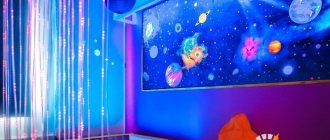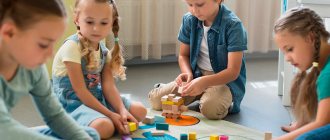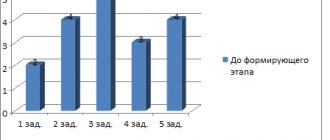Organization of the sensorimotor area in the second younger group
Dugushkina E.V. Organization of the sensorimotor area in the second younger group // Sovushka. 2022. N2 (20). URL: https://kssovushka.ru/zhurnal/20/ (access date: 02/05/2022).
Order No. 666543
In September 2022, our kindergarten welcomed a new group of 3-4 year old children. As a result of the diagnostics, it was revealed that the modern child experiences a lack of tactile, auditory, and olfactory sensations. Sometimes he perceives the world around him linearly, one-sidedly. To restore the fullness of perception through interaction with real objects is the main purpose of the sensorimotor corner, created today in many preschool institutions.
It is known that the greater the number of sensory systems involved in the process of raising and educating a child, the more successful and efficient his development occurs. Therefore, in our group we created a sensorimotor corner “The World of Sensory”.
The sensory corner is used in the educational process both in organized classes for teachers and in additional classes, as well as in independent play, search and experimental activities of children.
The sensorimotor corner in the group is intended to:
- to stimulate sensory functions (vision, touch, hearing, taste, smell, tactile sensation);
- for the development of fine motor skills, stimulation of motor activity;
- to relieve muscle and psycho-emotional tension, achieve a state of relaxation and comfortable well-being for children;
- creating a positive emotional background, increasing the child’s performance;
- activation of cognitive processes (thinking, attention, perception, memory);
- increasing motivation for independent and experimental activities of preschool children [1, p.13].
In our group there is a lot of different material for the development of tactile sensations. A large amount of natural material is used: cones, acorns, walnuts, beans, peas and much more. You can make hand massage baths filled with beans and peas. Children play with great pleasure in such baths, at the same time learning the shape, color, and size of objects. Many materials (natural and food) have been dyed in different colors.
Exercises are carried out using corner materials in order to highlight colors and shades in the environment. Children are invited to find in nature (in the kindergarten area, in a group, at home) objects whose color matches the proposed color card. Natural materials for games to develop tactile sensations should also be presented here. The kids like to create compositions from shells and natural materials. Naturally, the work is preceded by a conversation related to plants and seeds. And at the same time, children get acquainted with the properties of many materials, and develop tactile and finger sensations
A large amount of material was collected from various lids.
There is a homemade sensory panel “Seasons”. Children, while developing their hands, simultaneously consolidate knowledge about living and inanimate nature, the sequence of seasons. Based on this panel, educators can implement many didactic games and tasks.
We widely use various cereals, colored in different colors. Children enjoy stringing colorful large pasta onto a thread and making beads for their beloved mother. And how nice it is to plunge your palms into red pearl barley or green rice, complete the teacher’s tasks or look for certain objects.
But most of all, students of our age like to paint with their fingers on trays of semolina.
Basic principles of organizing the sensorimotor area:
- Availability;
- Safety;
- Creativity;
- Diversity of objects [2, pp. 23-24].
Contents of the sensorimotor area in the group:
Vision:
- Glowing cords, all kinds of unusual lamps (unbreakable) that give off reflections, any devices with interesting lighting effects;
- Illusion pictures (rotating spirals, three-dimensional images, etc.);
- Color spots-blots of various shapes;
- Multi-colored translucent scarves;
- Hatching pictures, hide-and-seek pictures;
- Multi-colored hourglasses, iridescent droplets, “perpetual motion machines,” etc.
Hearing:
- Cassettes and discs with sounds: the cries of domestic animals and birds, sounds of transport, sounds of the forest, sounds of water, etc.;
- Devices for creating sounds: rustles, rattles, whistles and other devices that make interesting sounds.
Touch:
- Pieces of fur, fabric, paper, various materials with different textures;
- Items for creating cold and hot (heating pad, ice trays);
- Convex letters, numbers;
- Various cereals in bags, trays for cereals, jars.
Smell:
- Natural, natural smells (coffee, mint, orange peels, etc.)
Taste:
- Cups, molds, plates, skewers for serving children of various tastes [3, p. eleven].
In the fall we tasted various vegetables and fruits.
Joint activities of the teacher and children outside of class in the sensorimotor corner.
- work in coloring books - shading;
- finger gymnastics - lacing;
- games with a constructor - mosaic;
- modeling from clay and plasticine;
- stringing beads;
- colored balls of thread;
- working with scissors.
We will continue this work in the sensorimotor corner we created, because it is very relevant in the development and education of preschool children and gives the children great pleasure! We will regularly update its content.
Literature:
- Karalashvili E.A., Antonenkova O.V. Organization of the sensorimotor corner in a kindergarten group // Directory of a senior teacher. 2008. No. 5.
- Nikitina E. Sensory corners for diagnostics // Hoop. 2006. No. 2.
- Soltseva O.G. Our helpers are the senses // Child in kindergarten. 2007. No. 3.


